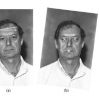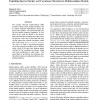193 search results - page 3 / 39 » Sparseness Achievement in Hidden Markov Models |
ICIP
2001
IEEE
14 years 7 months ago
2001
IEEE
Face recognition has become an important topic within the field of pattern recognition and computer vision. In this field a number of different approaches to feature extraction, m...
ICML
2009
IEEE
14 years 7 months ago
2009
IEEE
We consider Gaussian multiresolution (MR) models in which coarser, hidden variables serve to capture statistical dependencies among the finest scale variables. Tree-structured MR ...
NAACL
1994
13 years 7 months ago
1994
The processing of Japanese text is complicated by the fact that there are no word delimiters. To segment Japanese text, systems typically use knowledge-based methods and large lex...
CORR
2010
Springer
13 years 1 months ago
2010
Springer
In prediction with expert advice the goal is to design online prediction algorithms that achieve small regret (additional loss on the whole data) compared to a reference scheme. I...
ICASSP
2011
IEEE
12 years 10 months ago
2011
IEEE
We present a semi-supervised source separation methodology to denoise speech by modeling speech as one source and noise as the other source. We model speech using the recently pro...


